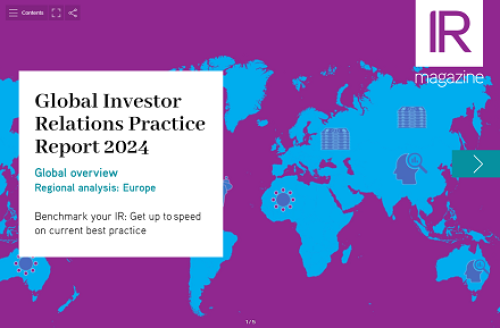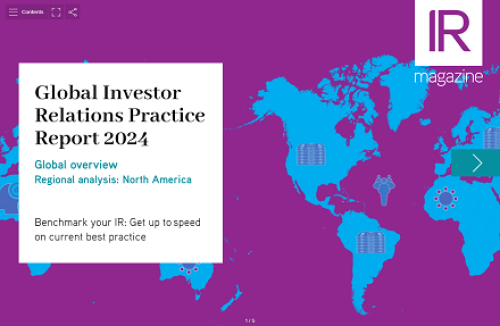Examining three case studies of companies tackling internal IR events, including reverse roadshows and IR roundtables
Whether it’s informing company strategy, sharing knowledge across divisions or educating employees about the workings of the stock market, the intelligence gathered by IR is too valuable not to leverage properly throughout the rest of a listed company.
A number of different approaches are taken by issuers to use their IR knowledge internally. Most teams meet with management or the board to share intelligence. Some departments embark on an internal roadshow, defined broadly as when the IR function travels with information usually reserved for investors and analysts, using it to educate middle management at other company locations. There is also a variety of ways to keep the rank and file updated on the company’s stock market performance, such as roundtables and newsletters.
| Internal education Investor relations can be leveraged as an internal tool, whether to improve overall strategy or to inform decisions by individual business units on a case-by-case basis. IR can also help explain to employees how public markets work, how companies are valued, and what drives long-term stock performance. How it’s done A number of approaches center around internal roadshows, whether these are trips to corporate sites, visits with management teams or similar. Investors and analysts can also attend so-called reverse roadshows or roundtable-style discussion events. What to consider IR as an internal communications tool might be a hard sell to senior management team members and business leaders initially, but once a format that suits the company has been determined, it becomes easy to see the benefits of an internal exchange of potential business intelligence. |
‘In our mind, IR acts as a two-way bridge, a special function that not only collects internal messages to convey externally to investors, but also collects market intelligence, external feedback, and so on for our internal team,’ says Gary Ng, head of IR at Chinese computer parts manufacturer Lenovo.
For Julie Tracy, senior vice president of IR at Wright Medical, there is a host of ways in which IR can bring value to her company internally. ‘IR can provide a valuable perspective and feedback from the Street to internal company constituents,’ she says. ‘We can share and summarize sell-side analyst reports on the firm and for industry peers so that the voice of the shareholder is represented internally.’
Tracy’s IR department also educates employees as to the importance of the stock market, its function and the role stock trading plays in the success of Wright Medical. ‘IR can educate employees on how public markets work, how companies are valued, and what drives long-term stock performance,’ she explains.
On the road
At Ferrovial, a mid-cap Spanish firm that builds and operates public transport in several countries, the head of IR carries his IR intelligence in person from office to office.
Ricardo Jiménez is the only member of the IR team who remains from just over a year ago, so his first objective this year has been to settle in with the new team, and then to engage the growing company’s employees. It’s vital ‘to consider [them] as important a stakeholder as any other shareholder,’ he says.
Employees are kept informed primarily through a wide net of internal information sharing that is funneled through the IR function. ‘We need people to know what IR is and what we bring to them, to be aware that we are a listed company and to understand that our team’s work is very important for us to convey the right image or perception of Ferrovial,’ Jiménez notes.
‘That image is not only about results, but also concerned with clear explanations and exploring new topics as innovations occur in our business.’
Next steps
How to use IR in this way depends largely on how a company already operates. ‘First, I would determine the forum that will work best at your company for using IR as an educational tool,’ advises Tracy. ‘For Wright Medical, it is through the quarterly IR roundtables. There are other options you could consider, including making a presentation during meetings of your management team or offering an ‘IR 101’ course for employees one or more times a year.’
Tracy adds that no matter what forum or format you choose, the core message is to explain what IR is in layman’s terms so that your new internal constituency can understand how shareholders determine your firm’s value. ‘Reviewing your shareholder composition and recent stock price performance is also good to cover with employees,’ she suggests. ‘And I would encourage you to consider inviting one of your sell-side and/or buy-side analysts to participate.’
The most important factor, says Ng, is to ensure you have the endorsement of your senior management – or at least to illustrate how powerful the discipline of internal education can be. This needs to be done ‘step by step, reaching out to relevant teams to build relations’, to ensure all parties are aware of the ‘exchange of potential business support’ IR can provide.
‘Sometimes we do an internal HR roundtable with different business functions and teams to let more people know what IR is doing,’ Ng adds.
His final piece of advice is one that could apply across the whole gamut of the IRO’s role. ‘Get the ball rolling and communicate!’ he says. ‘It’s as simple as that.’
Wright Medical's IR roundtables
Julie Tracy, head of IR at Wright Medical, and her team use IR to provide market and competitive intelligence, share feedback from the investment community and even review internal company communications, in order to ensure the firm’s messaging remains consistent.
The main tool in Tracy’s arsenal is a quarterly IR roundtable for Wright’s employees, typically an hour-long meeting held shortly after results disclosure. ‘I review our quarterly results, discuss the Street’s reaction to our results and our guidance, share a sampling of analyst reports, summarize quarterly changes in our shareholder composition and provide context and perspective on why our stock price has moved up or down,’ she explains.
There’s also an opportunity to explain how IR is positioning the company with the Street and how Wright’s progress is being measured by investors and analysts – sometimes with a guest speaker from the buy side or sell side. ‘This was particularly well received by employees, and the analysts also enjoyed the opportunity to interact with employees and get a feel for the corporate culture,’ Tracy explains.
Why was the event such a hit with Wright’s staff? ‘The vast majority of employees do not get an opportunity to interact with the actual owners of their company: the shareholders,’ Tracy says. ‘The idea was to give employees a view into what the owners of their firm were thinking and ultimately to help employees appreciate the important role they play, as individuals and collectively, as part of a team in doing what we say we will do as a company.’
As for true ‘internal’ roadshows, Wright’s IR team has yet to try them out. ‘I think it is a great idea and would like to try one in future – after our pending merger is completed,’ Tracy says. ‘It would give us an opportunity to visit company locations around the world and educate our employees on what role IR plays and how it contributes to ensuring a fair valuation for our company.’
Ferrovial's internal roadshows
Ricardo Jiménez, head of investor relations at Ferrovial, maintains a large program of keeping internal constituents informed, which includes an array of presentations and engagements throughout the financial year. First among these are two semi-annual presentations to Ferrovial’s board of directors, which share investor perception data, stock valuation and direct shareholder feedback in what Jiménez describes as ‘a very candid manner’.
The IR department also engages the firm’s business divisions individually. Not only does it present to each division’s management committee on an annual basis, but it also travels to each of Ferrovial’s divisions for a wider information exchange. This means the IR department can meet the people who are providing it with company data, Jiménez explains, and also that control departments can be met across the parent company and specific project managers can be consulted if their work is of interest to investors.
A roadshow of on-site visits is what Jiménez says makes the biggest difference to Ferrovial’s operations. He and his team go to one of the many sites at which Ferrovial (or its subsidiaries) operates, and there they advise on how to run different contracts, improve balance sheets or even generate cash flow, depending on intelligence from within or without the company.
Jiménez says that when visiting a high-speed train maintenance site, for example, he wowed attendees with the knowledge that they sold 3.3 mn bottles of water and 2.5 mn sandwiches a year – figures that shook up how that business went on to work.
Other trips have included a visit to London’s Heathrow airport to speak with retail managers, where IR staff presented the details and ramifications of a new terminal building and a design study of energy efficiency.
‘It’s about conveying the image of the company – not just in numbers, but many other aspects, too – and providing clear explanations of operational trends, innovation, corporate governance or even something like say on pay,’ Jiménez explains. ‘It’s about promoting understanding.’
Lenovo's reverse roadshows
What Gary Ng, head of IR at Lenovo, calls a reverse roadshow is similar to an internal roadshow, as management and internal teams are briefed on IR information, but Lenovo’s investment community is also brought along to both provide added context and offer intelligence.
‘We invite key analysts and investors to meet with our senior teams in order to share their insights on industries and trends,’ Ng explains. ‘We also provide updates for leadership and internal teams – from corporate communication, finance and strategy – about the latest market view on the industry and on us, while enlisting their support for market information exchange.’
Ng says feedback for Lenovo’s events has been particularly strong. ‘We have been doing these roadshows for quite a period of time and the teams appreciate it a lot as it provides them with additional viewpoints,’ he adds.
These buy-side and sell-side meetings are dealt with on a by-project basis, Ng explains, though in the past they have been held roughly once a year, if there are specific topics the leadership teams would like to learn more about directly. Otherwise, Lenovo’s team will build such questions into normal conversations with the investment community and collect feedback that way.
Beyond these, there is a range of tools Ng and his colleagues use on a day-to-day basis, including shareholder surveillance software, analyst and investor perception studies and analyst forecasts.
On a quarterly basis, they also ‘conduct internal calls at least quarterly with various teams, such as heads of geographical divisions, business units and functions, to exchange information,’ Ng notes.
‘We might not do this in a face-to-face format every time because many of our other internal teams are already spreading this communication globally, so we exchange information by email and via conference calls.’
This article appeared in the fall print issue of IR Magazine










